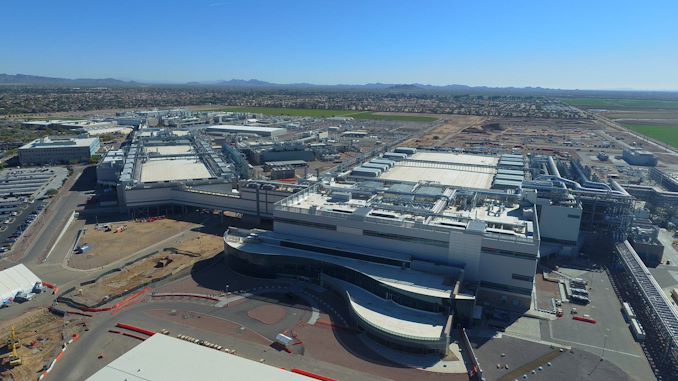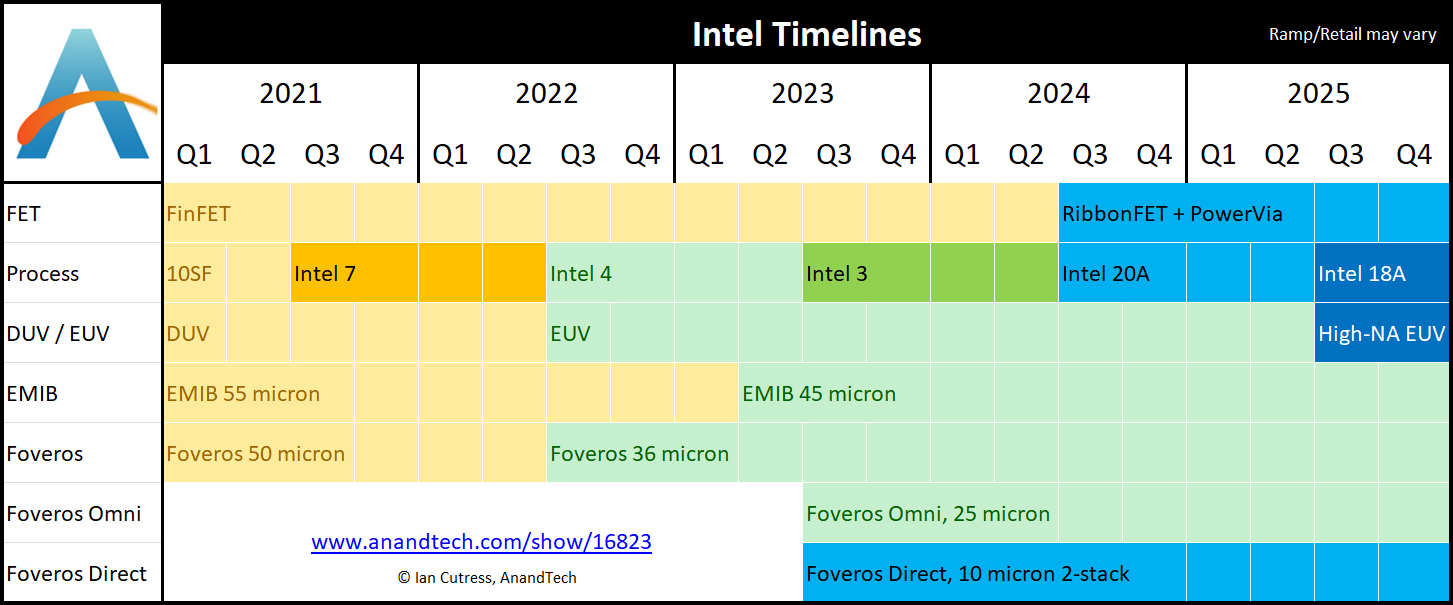Intel Foundry Services Drafted By US Department of Defense For Next-Gen Fab Needs
by Ryan Smith on August 23, 2021 7:00 AM EST- Posted in
- CPUs
- Intel
- Intel Foundry Services
- Foundry
- Intel 18A

Over the last couple of years, a great deal of concern has developed around the future of semiconductor manufacturing, both with respect to total capacity and where the next generation of fabs will be hosted. The current chip crunch has underscored that current fab capacity is too small for a world where there’s a silicon chip in practically everything, and meanwhile geopolitical matters have made nations increasingly worried about where today’s cutting-edge fabs are located – mostly in Taiwan and South Korea. Consequently, we’ve seen governments kick-start initiatives to woo fab companies or otherwise incentivize the domestic construction of next-generation fabs, including the United States Department of Defense, whom today is awarding Intel an agreement to provide commercial foundry services for the DoD.
As announced by Intel this morning, Intel’s Foundry Services group has secured an agreement with the United States Department of Defense to provide fab services under the Rapid Assured Microelectronics Prototypes - Commercial (RAMP-C) program. RAMP-C is one of several US government programs to encourage domestic chip production, with this program focused on chip production for defense needs. In short, the DoD wants to ensure it will be able to have its chips (and other necessary commercial hardware) fabbed within the United States on a leading-edge commercial manufacturing node, and it is tapping a consortium of companies lead by Intel to develop the necessary foundry ecosystem.
Along with Intel, the consortium also includes IBM, Cadence, Synopsys and other companies, all of whom will be providing their relevant expertise and technologies to the project. These companies will be working together on what’s a fairly forward-looking service agreement, as the DoD is looking at fab needs several years down the line. Ultimately, the group is being tasked with establishing a semiconductor IP ecosystem around Intel’s forthcoming 18A process – the most advanced process on their development roadmap – which isn’t due to start ramping until 2025.
At this point Intel and the DoD are not announcing the value of the services agreement. There is no doubt some hedging going on, and there are multiple milestones Intel & co will need to hit between now and 2025 as part of their participating in the RAMP-C program.
But in the meantime, even being able to claim the DoD as a major customer for Intel Foundry Services is a big win for the group, which is still in the early stages of lining up customers and proving that it has learned from past mistakes, both with regards to offering contract foundry services, and in operating a leading-edge fab ecosystem. As a reminder, Intel has previously announced that it will be spending around $20 billion to build a pair of new fabs in Arizona, so success for IFS hinges on finding big customers like the DoD to fill those fabs with orders.
Source: Intel











19 Comments
View All Comments
A5 - Monday, August 23, 2021 - link
Looking at that roadmap, it seems obvious for there to be new generations of the EMIB/Foveros packaging techs by then, too.I'd assume part of this agreement is development of mil-spec (shock tolerance, temp range, etc) advanced packaging methods?
Gondalf - Monday, August 23, 2021 - link
This doesn't mean we need to wait 18A process to see silicon manufactured for defence. Right now the 7nm process (N4) is thinked for foundry activities, it is TSMC 4nm class so perfect for defence needs. About the IP ecosystem, TSMC have not it, still manufacture for USA defence.Honestly we don't know much things about this topic, it is not unlikely that right now Intel is manufacturing something on 10nm for military, after all a 7nm foundry class process is not irrelevant in a situation of severe chips shortage, with TSMC that barely can ship enough 7nm wafers to satisfy the minimum request of customers.
Eliadbu - Monday, August 23, 2021 - link
Of course not, today many semiconductor products even from civilian companies (like FPGAs) are used by the defense industry. The idea of this deal is to assure that the US defense sector will have locally manufactured chips in the future. The reason for locally is there are concerns that any military skirmish in South Korea or Taiwan will cut off the US from crucial chips supply for its defense industry which is so depended on those chips. So the big picture is self reliance in terms of advanced wafers production.Manish_mv - Sunday, August 29, 2021 - link
I think it is a right move by US. Move of going into Afghanistan was not :)Ubiqutious - Monday, August 23, 2021 - link
There's only one company on the planet that makes the machines these guys need to use to make the chips. ASML in the Netherlands Are the planning to jump the queue for ordering machines as they are pre-ordered for years in advance already, or have they ordered already ?.https://www.msn.com/en-us/news/technology/asml-is-...
ilt24 - Monday, August 23, 2021 - link
@Ubiqutious Intel along with TSMC and Samsung funded the development of EUV (link below) and have had orders in the queue for years. Both ASML ability to deliver and Intel's delayed needs had pushed most of the production to TSMC and Samsung, but with ASML's production rising and Intel ramping up production of it's EUV process, Intel will be receiving a much larger number of machines going forward.https://www.forbes.com/sites/jimhandy/2012/08/27/w...
Note these investments were by way of purchasing stock and all three companies have since sold most if not all of these shares...and made huge gains on them.
https://www.eetimes.com/intel-again-cuts-stake-in-...
flgt - Monday, August 23, 2021 - link
Here we go…. Now we know the real reason Intel formed IFS, so they can get a giant government bailout in the form of the DoD. I can’t think of any worse to partners to screw over the American taxpayer. The whole reason all the defense electronic companies failed or got consolidated is that the DoD doesn’t actually buy anything anymore. That $1 trillion is trapped in never ending bureaucracy and DARPA boondoggles. It’s just engineering welfare at this point. It’s going to be interesting to see if Intel can make a fab work making fighter components the DoD will only buy a 1000 of for the life of the program. Meanwhile TSMC will be dialing in their process with 50 million Apple chips. Then taxpayers will get to pay commercial companies to suffer through using IFS.nandnandnand - Monday, August 23, 2021 - link
The new Intel backdoors will be extra shiny.Oxford Guy - Monday, August 23, 2021 - link
They’ll look nice adjacent to AMD’s, Apple’s, and so on. A whole happy family.Silver5urfer - Monday, August 23, 2021 - link
I didn't even think this perspective, good one. Makes a lot of sense. I think they have a ton of cash so they even threw money at TSMC for their collaboration plans on the IDM2.0 strat. Simply make Taiwan a political card in the big equation for the Intel corp and the DoD involvement on top of the Semiconductor leadership.Absolutely beats me how Intel from leader in x86 processor and Node design went from hero to absolute garbage zero. Greedy execs, incapable board of directors, and politics (poor politics in CA state ?). Shame.